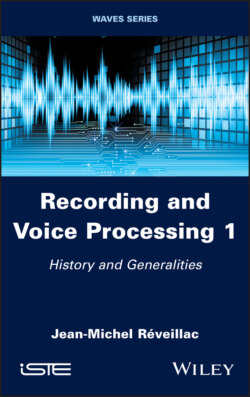Recording and Voice Processing, Volume 1

Реклама. ООО «ЛитРес», ИНН: 7719571260.
Оглавление
Jean-Michel Reveillac. Recording and Voice Processing, Volume 1
Table of Contents
List of Illustrations
List of Tables
Guide
Pages
Recording and Voice Processing 1. History and Generalities
Preface
Target audience
Structure and contents of the book
Conventions
Vocabulary and definition
Acknowledgments
Introduction
1. Recording History
1.1. In the beginning was the phonautograph
1.2. When it really started
1.3. Magnetic recording
1.4. The advent of 78 rpm
1.5. The magnetic tape and the LP
1.6. 8-track cartridges, mini-cassette and Trimicron
1.7. The compact disk and the advent of digital technology
1.8. Digital technology is essential
1.9. Hard disk recorder and minidisc
1.10. Microcomputer, direct-to-disk and DAW
1.11. To conclude
2. The Voice
2.1. The vocal apparatus and its functioning
2.2. Voice and breath
2.3. Song and speech
2.4. Frequency, intensity and timbre
2.5. Voice and range
2.6. Voice quality
2.7. Characteristics of the vocal timbre
2.8. Conclusion
3. Microphones
3.1. A little history
3.2. The characteristics of a microphone
3.2.1. General characteristics. 3.2.1.1. Transducer technology
3.2.1.2. Noise level
3.2.1.3. Signal-to-noise ratio
3.2.1.4. Output impedance
3.2.1.5. Sensitivity
3.2.1.6. Frequency response
3.2.1.7. Maximum allowable sound pressure
3.2.1.8. Directivity
3.2.1.8.1. Omnidirectional
3.2.1.8.2. Hemispheric
3.2.1.8.3. Bidirectional
3.2.1.8.4. Cardioid
3.2.1.8.5. Supercardioid
3.2.1.8.6. Hypercardioid
3.2.1.8.7. Subcardioid
3.2.1.8.8. Gun or shotgun
3.2.2. Specific characteristics. 3.2.2.1. Membrane width
3.2.2.2. Amplification type
3.3. Microphone families
3.3.1. Microphone and transformer
3.3.2. Dynamic moving coil microphones
3.3.2.1. Some dynamic moving coil microphones
3.3.3. Ribbon microphones
3.3.3.1. Some ribbon microphones
3.3.4. Condenser microphones
3.3.4.1. Some condenser microphones
3.3.5. USB microphones
3.3.5.1. Some USB microphones
3.4. Uses of microphones according to their directivity
3.4.1. Omnidirectional microphones
3.4.2. Bidirectional microphones (figure-8)
3.4.3. Cardioid microphones
3.5. Conclusion
4. The Acoustic Environment
4.1. Location of pickup and sound isolation
4.2. Acoustic processing
4.2.1. State of the art
4.2.2. Bass traps
4.2.2.1. Porous absorber bass traps
4.2.2.2. The Helmholtz resonator bass traps
4.2.2.3. Membrane or flexing bass traps
4.2.2.4. Active or electronic bass traps
4.2.2.5. Manufacturers
4.2.3. Acoustic diffusers
4.2.3.1. Suppression of comb filtering
4.2.3.2. Equal distribution of sound energy
4.2.3.3. Enlargement of the space
4.2.3.4. Homogenization of the frequency response
4.2.3.5. Suppression of unwanted echoes
4.2.3.6. To go a bit further
4.3. Acoustic booths
4.4. Accessories
4.4.1. Acoustic shields
4.4.2. Pop filters
4.4.3. Headphones
4.4.4. Microphone suspensions
4.4.5. Feet, poles, and arms
4.4.6. Bonnets
4.5. Conclusion
Conclusion
Appendices
Appendix 1. Sound Unit. A1.1. Introduction
A1.2. Bel and decibel
A1.3. The different variants of the dB
A1.4. Conclusion
Appendix 2. Audio Connectivity. A2.1. Introduction
A2.2. Coaxial jack
A2.3. XLR plug
A2.4. XLR cables and adapter jacks
A2.5. USB connector
A2.6. Sub-D connector
A2.7. BNC connector
A2.8. RCA connector
A2.9. Toslink connector
A2.10. Conclusion
Appendix 3. Audio Processing Plugins. A3.1. Introduction
A3.2. Compression plugins
A3.3. Equalization plugins
A3.4. De-Esser plugins
A3.5. Delay and reverb plugins
Appendix 4. Tube and JFET Microphone Amplifiers. A4.1. Introduction
A4.2. Operating principle of tube microphones
A4.3. JFET microphones
Appendix 5. Microphone Pairs. A5.1. Introduction
A5.2. The AB pair
A5.3. The XY pair
A5.4. The ORTF pair
A5.5. The MS pair
A5.6. The Decca tree
A5.7. The Blumlein method
A5.8. The Faulkner Array
A5.9. The sound-absorbing disk method
A5.10. The artificial head
A5.11. Conclusion
Glossary. A
B
C
D
E
F
I
J
L
M
P
Q
R
S
T
U
V
X
References
Hyperlinks
Software publishers
Hardware manufacturers
Talkback
Plugins
Acoustics
Vocoder
Home Studio
Sound effects
Audio filtering
The voice
Audio software tutorials
Interfaces and communication
General sites
Index
WILEY END USER LICENSE AGREEMENT
Отрывок из книги
Jean-Michel Réveillac
.....
The conclusion sheds light on the whole book and gives a brief overview of the future evolution of voice recording.
Each volume can be read separately. While there are concepts that are dependent on another chapter, references to the relevant sections are given. However, the first two chapters of Volume 1, devoted to the history of recording and to the human voice, provide a contextual basis for the understanding of several notions that you will find in the following chapters.
.....